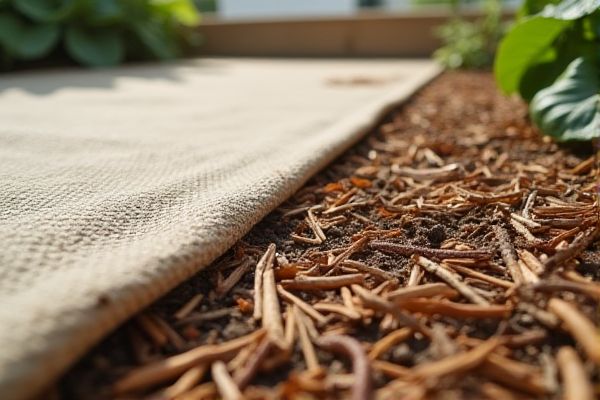
Weed barrier fabric offers long-lasting protection against unwanted plants by blocking sunlight and allowing water to pass through, while cardboard mulch provides a biodegradable, eco-friendly alternative that improves soil health as it decomposes. Discover which option best suits Your gardening needs by exploring the detailed comparison ahead.
Table of Comparison
| Feature | Weed Barrier Fabric | Cardboard Mulch |
|---|---|---|
| Material | Woven or non-woven synthetic fabric | Recycled corrugated cardboard |
| Weed Control | Effective at blocking light, prevents weed growth | Blocks light, biodegradable, suppresses weeds naturally |
| Durability | Lasts multiple seasons (3-5 years) | Breaks down in 6-12 months |
| Soil Health | May limit water and air penetration | Improves soil structure and adds organic matter |
| Installation | Requires staples or pins, professional install preferred | Easy to lay down, overlaps naturally |
| Cost | Higher upfront cost | Low to no cost, often free recycled material |
| Environmental Impact | Non-biodegradable, synthetic | Biodegradable, environmentally friendly |
| Ideal Use | Long-term weed control in permanent beds | Temporary weed suppression and soil improvement |
Introduction to Weed Barrier Fabric and Cardboard Mulch
Weed barrier fabric is a durable, woven or non-woven textile designed to suppress weed growth by blocking sunlight while allowing water and air to penetrate the soil. Cardboard mulch consists of layers of biodegradable cardboard spread over soil, effectively preventing weeds by creating a physical barrier and enhancing soil health as it decomposes. Both methods serve as eco-friendly solutions for weed control, but differ in material composition, longevity, and impact on soil ecology.
How Weed Barrier Fabric Works
Weed barrier fabric functions by blocking sunlight, which inhibits photosynthesis and prevents weed seeds from germinating. Its tightly woven synthetic fibers allow water and air to penetrate while creating a physical barrier that suppresses weed growth. Unlike cardboard mulch, weed barrier fabric provides long-lasting durability and requires less frequent replacement in garden beds.
The Mechanics of Cardboard Mulch
Cardboard mulch works by blocking sunlight, which inhibits weed growth by preventing photosynthesis. Its biodegradability allows it to break down over time, enriching the soil with organic matter and improving moisture retention. Using cardboard mulch in your garden creates a natural barrier that suppresses weeds while enhancing soil health effectively compared to synthetic weed barrier fabrics.
Installation Process: Fabric vs. Cardboard
Weed barrier fabric installation involves rolling out the durable, breathable sheets over soil and securing them with landscape staples to prevent weed growth while allowing water and air penetration. Cardboard mulch requires layering flattened cardboard over the planting area, overlapping edges to block sunlight, and then covering it with organic mulch to enhance decomposition and soil enrichment. Both methods are effective, but fabric offers quicker installation with reusable properties, whereas cardboard provides a fully biodegradable solution that improves soil health over time.
Effectiveness in Weed Control
Weed barrier fabric provides superior weed control by creating a durable, breathable barrier that blocks sunlight, preventing weed germination while allowing water and nutrients to penetrate the soil. Cardboard mulch also suppresses weeds by blocking light and gradually decomposes, enriching the soil, but it may require more frequent replacement due to faster breakdown. Both options reduce weed growth effectively, but fabric offers longer-lasting protection, making it ideal for persistent weed problems.
Impact on Soil Health and Microbes
Weed barrier fabric can restrict water and air flow to the soil, potentially inhibiting microbial activity and reducing soil health over time. In contrast, cardboard mulch decomposes naturally, enriching the soil with organic matter and promoting a thriving microbial ecosystem. Organic decomposition from cardboard supports nutrient cycling and improves soil structure, enhancing long-term soil vitality.
Water Retention and Drainage Comparison
Weed barrier fabric offers superior water retention by allowing moisture to pass through while preventing soil erosion and weed growth, maintaining optimal soil hydration. Cardboard mulch also retains water effectively by absorbing moisture and slowly releasing it to the soil, but it can become waterlogged and may impede proper drainage if too thickly applied. Overall, weed barrier fabric provides more consistent drainage, reducing the risk of root rot compared to cardboard mulch, which is better suited for slower moisture release and organic matter enrichment.
Environmental Impact and Sustainability
Weed barrier fabric is typically made from synthetic polymers like polypropylene or polyester, which may persist in the environment for decades, contributing to plastic pollution if not properly disposed of. Cardboard mulch, composed of biodegradable cellulose fibers, breaks down naturally and enriches soil by adding organic matter while suppressing weeds effectively. From a sustainability perspective, cardboard mulch supports soil health and reduces waste through composting, making it a more eco-friendly option compared to non-biodegradable weed barrier fabrics.
Long-Term Cost and Maintenance
Weed barrier fabric offers durable resistance to weed growth, reducing the need for frequent replacement and lowering long-term maintenance costs compared to cardboard mulch, which decomposes faster and requires regular replenishment. Cardboard mulch improves soil health by adding organic matter but may incur higher costs due to its shorter lifespan and the labor involved in reapplication. Your choice depends on balancing initial expense with ongoing upkeep, where fabric excels in longevity while cardboard supports soil ecology.
Which Mulching Method is Best for Your Garden?
Weed barrier fabric offers long-lasting durability and superior weed control by blocking sunlight effectively, making it ideal for perennial garden beds with heavy weed pressure. Cardboard mulch, on the other hand, is biodegradable and enriches soil as it breaks down, perfect for vegetable gardens or areas where soil health is a priority. Choose weed barrier fabric if you want low maintenance and years of protection, while cardboard mulch suits your garden if you prioritize organic soil improvement and easy application.
 homyna.com
homyna.com